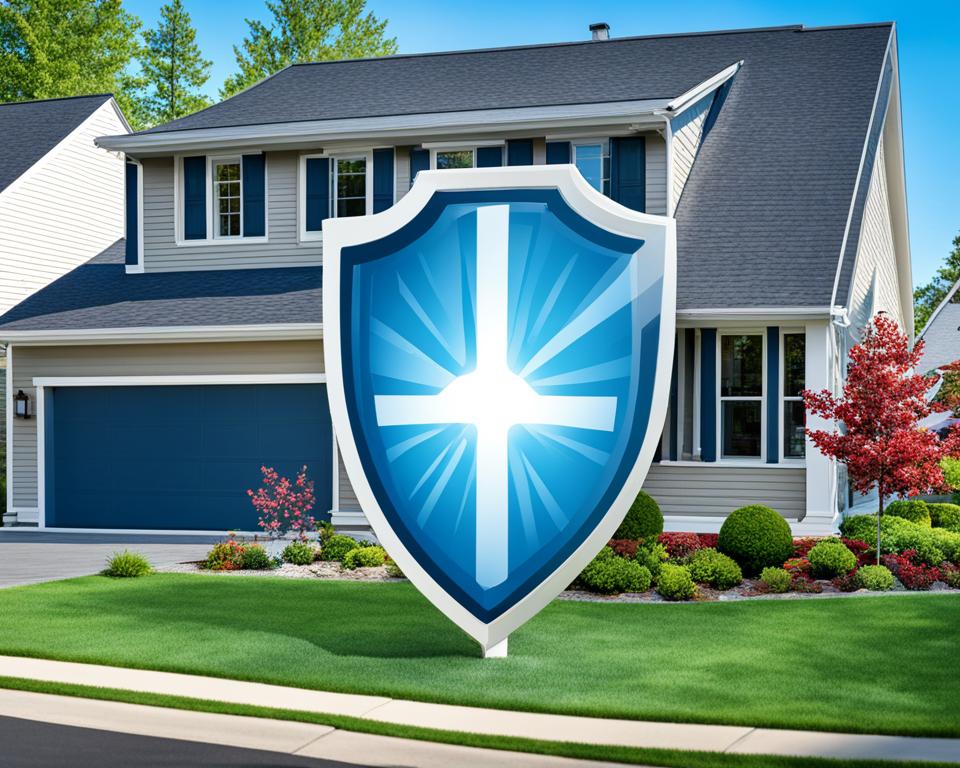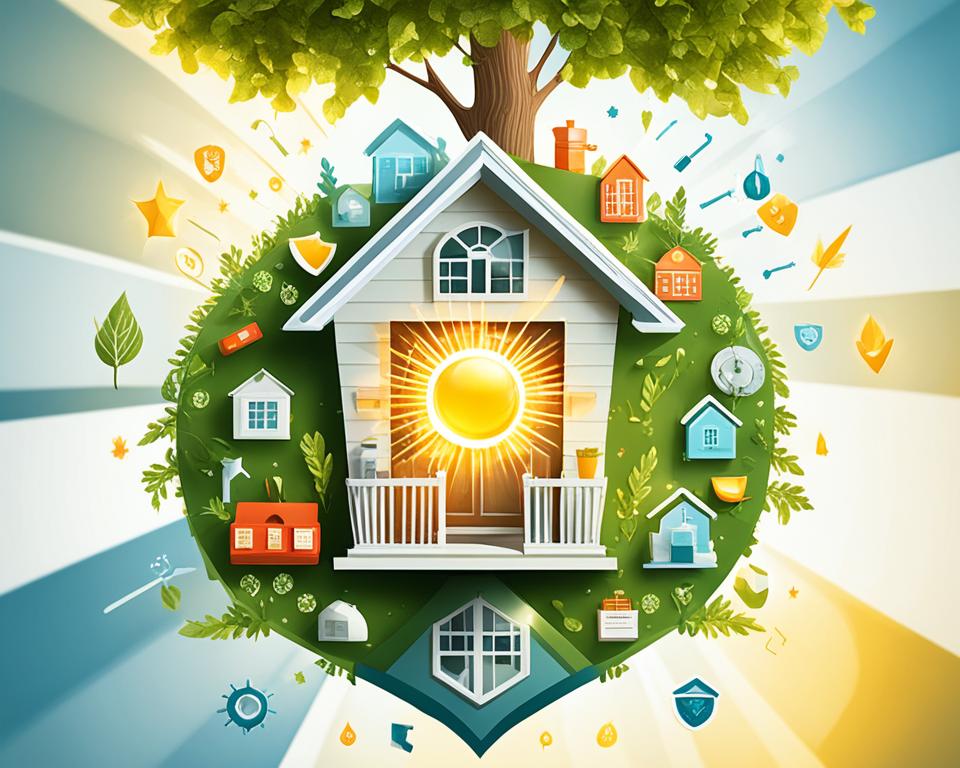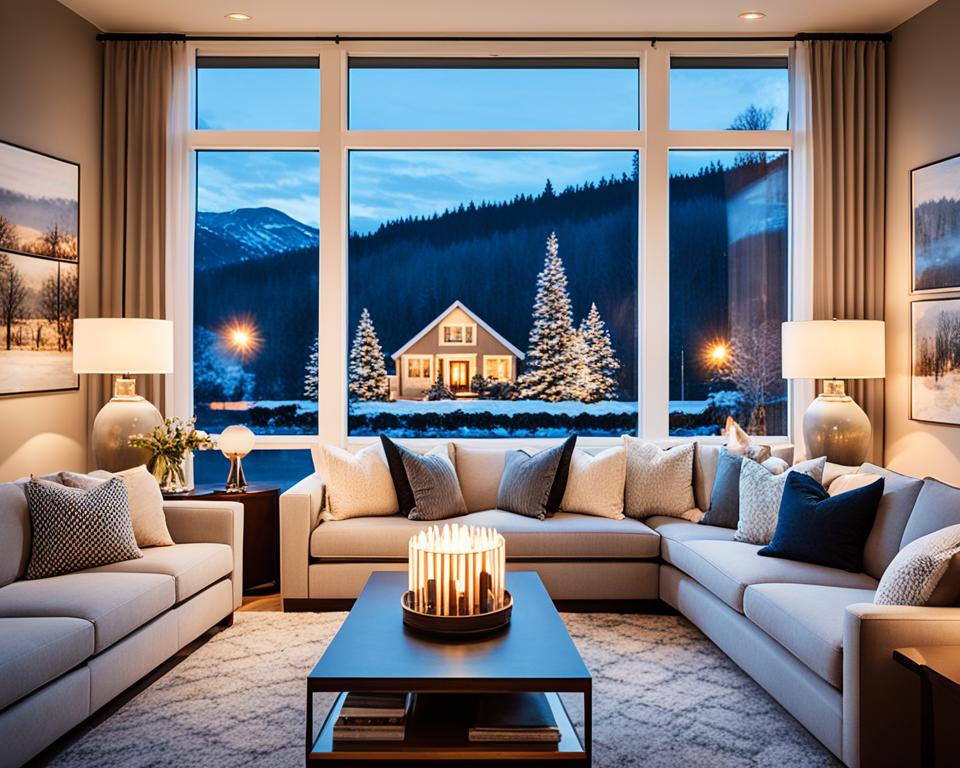Homeowners’ insurance is crucial for safeguarding our homes, our most valuable asset. It is often required by mortgage companies. This is to ensure the cost to rebuild, if necessary, is covered fully.1 If a disaster strikes, your insurer helps you and, if applicable, your lender.
For those who don’t own their homes, renters insurance is important too. It’s usually a must to protect what you own from damage or theft. Landlords typically ask for proof of this coverage from renters.
Key Takeaways
- Homeowners’ insurance provides essential financial protection for your home, belongings, and liability.
- Coverage can include repairs, replacement, and additional living expenses in the event of a covered disaster.
- Liability coverage shields you from lawsuits and medical expenses if someone is injured on your property.
- Understanding the different coverage options, such as actual cash value and replacement cost, can help you choose the best policy for your needs.
- Factors like location, home age, and security features can impact the cost of your homeowners’ insurance premiums.
Introduction to Homeowners’ Insurance
Homeowners’ insurance is more than a luxury today. It’s a must-have. It keeps our homes and most prized belongings safe from harm. We all know how important it is to protect our homes from floods, theft, and other risks.1
Why Homeowners’ Insurance is a Necessity
Having homeowners’ insurance is key because many lenders insist on it. They want their investment in your property protected. If a disaster, like a fire, strikes, insurance helps you rebuild. Even if you own your place outright, renting out your home also often requires insurance for tenants. This shows how vital it is to have this kind of coverage.
Understanding the Basics of Homeowners’ Policies
Homeowners’ policies guard against many risks. They cover damage to your house inside or out and stolen personal items. These policies also take care of some costs if you have to live elsewhere while your home gets fixed.1
It’s important to know what your policy includes. You should understand the coverage, limits, and what it doesn’t cover. This knowledge is vital for adequate protection of your home and belongings.
Coverages Provided by a Homeowners’ Policy
Homeowners’ insurance covers many things. It includes coverage for your house and any structures attached to it. This protection guards against risks like fires and storms.2 It also includes protection for detached structures such as garages and sheds.2
Damage to the Interior or Exterior of Your Home
If your home is damaged by fire, hurricanes, or other disasters, your insurance will help repair or rebuild it.2 However, damage from floods and earthquakes is usually not covered. You’d need an additional policy for that.2
Protection for Personal Belongings
Your insurer can cover your belongings, whether at home or not, in case of specific dangers.2 This includes clothing, furniture, and appliances if they’re destroyed in a covered event.2 Coverage can extend to lost jewelry, for example, even if it happened far from home.2 Plus, insurance usually covers a portion of the home’s value for detached structures and personal items.3
Personal Liability Coverage
Liability coverage helps if someone sues you, even because of your pets.2 Usually, it starts at $100,000, but people with more to protect might need more coverage.3
Additional Living Expenses Coverage
If you must leave your home for a while, this type of coverage is crucial. It pays for rent, hotel stays, and even meals.2 Extra living expenses have specific limits and timeframes.3 It also includes lost rental income for landlords.3

Types of Homeowners’ Coverage
Homeowners can pick from several insurance coverage levels for their home and items. The main types are actual cash value, replacement cost, and guaranteed or extended replacement cost/value. Each type provides different levels of protection and money for repairs.4
Actual Cash Value Coverage
With actual cash value (ACV) coverage, you get the value of your home and items minus depreciation. So, you receive what your items are worth now, which might be less than you paid originally.4
Replacement Cost Coverage
Replacement cost policies pay the actual cash value without subtracting for depreciation. This means you can fix or rebuild your home to its full initial value.4
Guaranteed or Extended Replacement Cost/Value Coverage
The most complete option is the guaranteed (or extended) replacement cost/value coverage. It pays to fix or rebuild your house, even if it’s over your policy limit. Some companies offer extended replacement cost, which goes beyond your original coverage amount but by about 20% to 25% more.4
Picking the best dwelling coverage, personal belongings insurance, and coverage limits is crucial for full home and item protection.5
What Homeowners’ Insurance Doesn’t Cover
Homeowners’ insurance offers broad coverage for many types of damage. However, it doesn’t cover everything. For example, it usually excludes floods and earthquakes.6 Some policies might have limited coverage for sinkholes, but not all do.6 And, they often don’t cover damage from sewer or drain backups.6
Natural Disaster Exclusions
When natural disasters strike, standard policies may not cover all losses. They often exclude floods and earthquakes.6 To protect against floods, you need a separate policy from the NFIP.6 Similarly, earthquake insurance is separate from standard plans.6 Yet, tornado damage is usually included. Windstorms and hail are covered, but not flood damage they cause.6
Home Repair and Maintenance Costs
Home insurance doesn’t usually pay for wear and tear or damage from pests.7 This includes termites, rodents, mold, and mildew if you haven’t kept up with maintenance.7 It also doesn’t cover neglect such as failing to fix a leaking roof.7
Acts of War, Terrorism, or Intentional Damage
Insurance usually won’t cover damage from war, terrorism, or nuclear events. It also excludes damage caused intentionally by the policyholder.7
It’s key to know what your insurance doesn’t cover. This helps protect your home better. With this knowledge, you can lower risks and add extra coverage where needed.

Determining Homeowners’ Insurance Rates
Insurance companies look at many risk factors to set homeowners insurance rates. They check the homeowner’s claims history and the property’s too.1 Past claims tell them about the chance of more claims later. If the owner has filed many claims, or if the property has had issues, rates might go up. Also, how good the homeowner’s credit history is can influence the premium. Lower credit scores could mean paying more.8
Neighborhood crime rates and the ease of getting building materials also matter for insurance rates.1 High-crime areas raise the risk for the insurance company. So, living in such a place may mean higher rates. If it’s hard to find materials for fixing or rebuilding, that too may increase costs.1
The options a homeowner picks, like deductibles and special coverages for items such as art or jewelry, can change the insurance premium.1 Choosing higher coverage amounts or lower deductibles usually means paying more each year. But, picking lower coverage amounts or higher deductibles can help lower rates.8
Almost anything that might raise claim risk can impact homeowners insurance rates. For example, a house that’s not well-kept might mean more chances for damages. If a certain dog breed is known for causing harm, it could also be a factor. In the end, insurance companies decide rates based on their view of damage payout likelihood.1
| Factor | Impact on Homeowners Insurance Rates |
|---|---|
| Claims History | Past claims submitted by the homeowner and the property can increase rates.18 |
| Credit History | Poor credit may lead to higher insurance premiums.8 |
| Neighborhood Crime Rate | Higher crime rates in the area can contribute to increased insurance costs.1 |
| Building Material Availability | Limited availability of materials needed for repairs or rebuilding can result in higher premiums.1 |
| Coverage Options | Choosing higher coverage limits or lower deductibles typically leads to higher annual premiums.18 |
| Home Condition | Poorly maintained homes may have a higher likelihood of requiring major repairs, impacting rates.1 |
| Breed of Pets | Certain dog breeds that are more prone to causing damage can contribute to higher insurance costs.1 |
Homeowners’ Insurance Benefits
Financial Protection for Your Home and Belongings
Homeowners insurance is designed to protect your home and its contents.9 It covers damage to your home’s structure from things like fires and storms.10 It also includes personal belongings such as clothes and furniture.
If you can’t stay in your house, it helps pay for things like rent or hotel stays.9
Peace of Mind and Security
This insurance gives you peace of mind.9 It means you can rebuild your home if a disaster strikes.
In 2017, the NAIC looked into how people choose home insurance because of changing weather patterns.9 With the right policy, you won’t have to worry about the cost of repairs.
Liability Coverage for Accidents and Injuries
Homeowners insurance also covers you if someone gets hurt at your place.10 It helps with medical bills if, say, your dog nips a neighbor or if someone’s hurt at your house.9
The typical liability coverage ranges from $100,000 to $500,000.11 For medical bills you might cause away from home, it’s usually $1,000 to $5,000.

| Coverage Type | Typical Coverage Amount |
|---|---|
| Damage to home and attached structures | Enough to rebuild your home11 |
| Stand-alone structures on your property | 10% of dwelling coverage11 |
| Stolen or damaged belongings | 50% to 70% of dwelling coverage11 |
| Temporary living expenses | 20% of dwelling coverage11 |
| Liability coverage for bodily injury or property damage | $100,000 to $500,00011 |
| Medical payments coverage | $1,000 to $5,00011 |
Factors Affecting Homeowners’ Insurance Premiums
Several factors determine our homeowners’ insurance costs. The main one is the coverage level we pick. If you insure a $400,000 home, your premium will usually be higher than if your home is worth $200,000.8 The deductible we choose matters too. A higher deductible means lower monthly costs but more money from our pocket if we need to claim.8
Location and Neighborhood Factors
Location plays a big part in insurance costs. Being close to a fire station can help lower your rates a bit.8 Yet, living in a risky area or high-crime spot can raise what you pay.12 In wildfire areas in California, you might see extra charges from 15% to over 300%.13 In Florida, where hurricanes hit, homeowners might pay over $4,000 extra a year.13
Home Construction and Age
The age and type of home affect insurance prices too. Newer homes can cost less to insure than older ones.12 For homes older than 30 years, insurance might cost 75% more.13 Insurers also look at the home’s roof, systems, and special features. Your premiums may go up if you do big renovations that raise the home’s replacement value.12
FAQ
What is the purpose of homeowners’ insurance?
What types of coverage do homeowners’ insurance policies provide?
What are the different levels of homeowners’ insurance coverage?
What types of events and perils are typically excluded from homeowners’ insurance coverage?
What factors are used to determine homeowners’ insurance rates?
What are the key benefits of having homeowners’ insurance?
How can I lower my homeowners’ insurance premiums?
Source Links
- https://www.investopedia.com/insurance/homeowners-insurance-guide/
- https://www.towneinsurance.com/personal/personal/property/home/parts/
- https://www.iii.org/article/what-covered-standard-homeowners-policy
- https://www.bankrate.com/insurance/homeowners-insurance/types-of-homeowners-insurance/
- https://www.nationwide.com/lc/resources/home/articles/types-of-homeowners-insurance
- https://doi.colorado.gov/my-homeowners-insurance-doesnt-cover-what
- https://go.homesite.com/blog/whats-not-covered-standard-homeowners-insurance-policy-1
- https://www.bankrate.com/insurance/homeowners-insurance/factors-that-impact-home-insurance-rates/
- https://content.naic.org/cipr-topics/homeowners-insurance
- https://www.usnews.com/insurance/homeowners-insurance/what-does-homeowners-insurance-cover
- https://www.nerdwallet.com/article/insurance/understanding-homeowners-insurance
- https://www.policygenius.com/homeowners-insurance/factors-affecting-home-insurance-premiums/
- https://www.experian.com/blogs/ask-experian/factors-that-impact-homeowners-insurance-costs/
